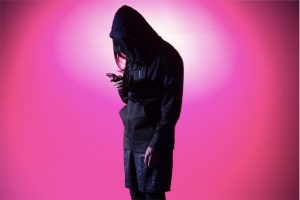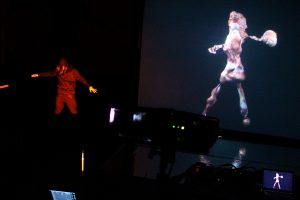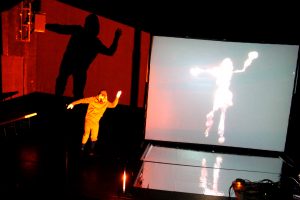Caden Manson and Jemma Nelson founded Big Art Group in 1999 in New York City as a company for the creation of contemporary performance. Big Art Group’s work exists in the contemporary stream of expanded performance, wherein  traditional narratives and established performer-audience relationships have been opened up to create possibilities of innovative discovery. Big Art Group blends high and low technology, marginal and mainstream culture, and blunt investigation to drive questions about contemporary experience. Manson and Nelson also created the social network and website ContemporaryPerformance.com for the exchange, diffusion and innovation of ideas in contemporary performance by global artists, and host an annual festival in New York’s Lower East Side in January called Special Effects, to showcase experiments in new practices in the field.
traditional narratives and established performer-audience relationships have been opened up to create possibilities of innovative discovery. Big Art Group blends high and low technology, marginal and mainstream culture, and blunt investigation to drive questions about contemporary experience. Manson and Nelson also created the social network and website ContemporaryPerformance.com for the exchange, diffusion and innovation of ideas in contemporary performance by global artists, and host an annual festival in New York’s Lower East Side in January called Special Effects, to showcase experiments in new practices in the field.
This March Caden Manson and Jemma Nelson of Big Art Group were in residence at the Fisher Center for Performing Arts working on Opacity, which will preview at WE’RE WATCHING in April. On the snowiest day of the year, when the Fisher Center, along with all of Bard campus was shut down due to snow, I had a phone conversation with Manson and Nelson, who, despite the flurries and the closures, continued to work with their creative team at their lodgings in nearby Germantown.
Anna Gallagher-Ross: How are you doing on this snow day?
Caden Manson: We have food, we have booze. We are working. Everyone is here. We have live motion capture and 3D models in the kitchen, we have surveillance research in the living room, and some performance exercises in the basement.
AGR: Who is here with you on this residency?
CM: With us is an assistant video designer, a performer who is also doing the 3D modeling and live motion capture, and an assistant director who is compiling a lot of the interviews and documents, the language we are using for our script. Such as it is.
AGR: Could you say a bit more about this script, such as it is?
CM: It’s a “love story.” We wanted a simple story that was commonplace, very quotidian, so we decided it would be a person looking through apps to connect. This person finds someone, goes and has coffee, and actually connects with another person. They then decide to go somewhere more intimate, and all the while they are using interfaces to find each other, find the place to meet, find the place to go to, find the car to get into, use a map to get to the place they are going to. These interfaces are pervasive. There are five scenes, and each scene is built out of five search terms. We select the five terms, and then we use a Python program to scrape Twitter, which means to collect a thousand recent tweets that use those terms, and then we build the script from that. The script is then live fed to the performer’s ears, and they speak those lines to one another.

Photo by Anya Kopischke ’17.
Jemma Nelson: We are using natural language generation techniques, or methods of creating understandable texts via computational analysis and synthesis. Unlike research or commercial natural language applications, however, we are less concerned with the “sense” of the generated texts—we like the absurdity and abstraction of our results.
AGR: Where on the Internet are these texts coming from?
CM: We use Twitter but also search results of different engines and more long-form websites. We have two sets of search terms, because the the play begins with language about trying to connect online. For that we use search results based around this theme. And as we progress through the play, we begin to add terms about surveillance and security. So what starts as a script about two people trying to connect online, a kind of love story about meeting in real life through these interfaces, slowly becomes inflected by the language of freedom and surveillance and security.
AGR: This show is built around the framework of the interface. Could you speak about the inspiration for this project and also what you mean by interface?
CM: What we mean by interface is the GUI (graphical user interface) that you use to communicate and project yourself through, usually via computer or phone. These opaque user interfaces of apps like Twitter, Instagram, Yelp, Messenger, and Maps. We are interested in the way the visual that you look at on your phone hides all of the technology and code behind it, and how that’s dangerous. Also how that affects the way we relate to each other, or connect.
JN: More abstractly, the interface is a boundary site, a border line; an exchange that enables us to access information, that promotes usability, but in that process things get translated and things get changed, and sometimes those processes that happen at that site are hidden and not visible to us, and so they are taken for granted. That error, change and failure are part of the inspiration or interest in it for us.

Photo by Anya Kopischke ’17.
AGR: These interfaces say a lot about who we are and how we live, but also who makes them. What is the relationship between surveillance and the interface? The relationship between opacity and surveillance?
JN: We have entered a new era of mass data surveillance, a sort of statistical era where a lot of what our society is governed by is the data that is collected. We know that this data is driving decisions on a governmental level, on a scientific level, on a healthcare level, but we also know now that it is driving decisions on a personal level. For instance, it impacts how we decide to meet someone. The idea that I’m going to go meet someone, or I am going to try find a stranger to meet in a romantic way or even in a social way is now governed by this transition through the interface. What concerns us is what you are being shown, but also what you are not being shown. The categories that are being assigned for you, to you, that you take part in choosing. There are lots of decisions being made about visibility and invisibility. Most of those decisions around that, whether done by companies or government regulations, are not visible to us, and we take a lot of what is displayed on a screen for granted. We look at a new version of a phone or computer, or even more abstract interfaces, and we don’t pay attention to the potentially sinister implications of commonplace elements: ratings, location services, snapshots.
AGR: It seems that each new version of these interfaces have less and less holes—they are increasingly more impermeable, more opaque.
JN: As we talk about working in the cloud, and all these intelligent devices, the impact of surveillance surrounds us more and more, and yet in that surrounding, in these decisions, there are little ‘micro’ decisions that may seem benign, that function to categorize a person, or designate where they live, for example, but these things can have real world effects on a number population scale, and we don’t understand those effects yet. But all these structural things are now being built into how we interact with the world, how we see the world, and how we project ourselves out to the world.
AGR: What role do you see the spectator having in April?
JN: We are thinking about this performance as a kind of machine, as a program in itself, and so we’re thinking of the way we are giving it directives. The show changes based on different participants and it is flexible in a way so that the language can be swapped out, the certain triggers in the piece can be swapped out, generating new conversations. So we are thinking of it performatively in a different way. Its designed to be so it’s not fixed in the way you’d think of a conventional play.
CM: It is a different way of working with the performers because they are more participants than they are performers. For me, in the history of Big Art Group, our work is rehearsed within and inch of its life, and is comprised of hundreds and hundreds of cues, which are played by the people, you know, we don’t have stage managers, everyone is playing their own instrument—a light is an instrument, the media instrument, the sound is an instrument. And for this piece, although it is a quieter piece, it is a lot more out of control. It’s got all these “if-thens,” a series of hypotheticals, of possibilities. It starts off so that the audience can understand the situation and the language makes sense together, but then we place a schism in scene four, we break the story. The language, as that connection happens for them, changes from them talking about wanting to get together and find intimacy, to fears of surveillance and of being watched.
To find out more and to purchase tickets click here.